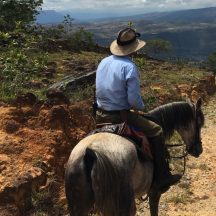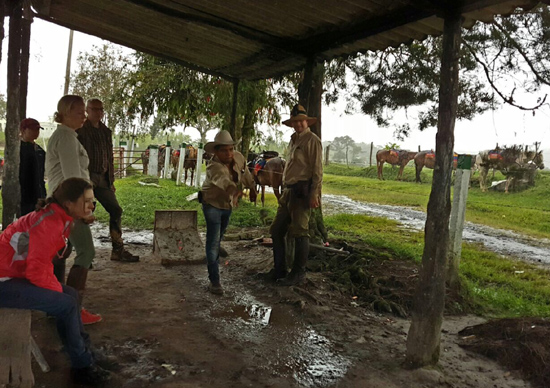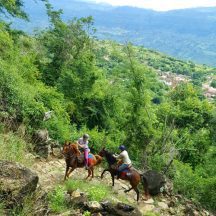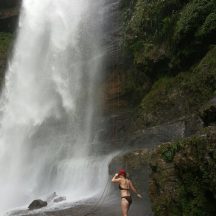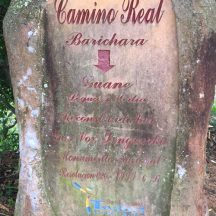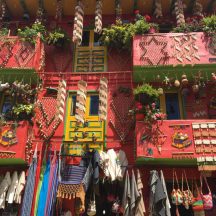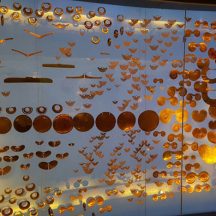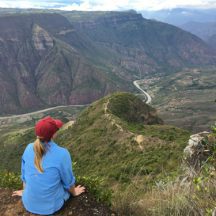The Barichara Ride in Colombia is designed especially for adventurous and inquisitive riders who want to participate in a challenging and unique experience. Here you discover the extreme landscapes of Colombia as you follow the Royal roads used firstly by the Conquistadors, the traders and later by the revolutionaries and independence fighters against their Spanish king in the early part of the 19th century. The routes will lead you from the historic lands of Boyacá to the state of Santander; explore wild and diverse landscapes, as well as historic villages bustling with a vibrant and colorful culture. People have known hardship and adversity in the recent past but they are now emerging into the future with a sense of renewed freedom and energetic independence.
Your host and guide is Julio Pardo, an experienced horseman and Colombian national who has dedicated much of his life to breeding and cultivating equestrian athletes, first in the competitive sport of polo, then for the long distance demands of endurance racing and now for the trail of discovery. Together with a hardworking ground team, he shares with you the unique relationship of horse and rider, the physical demands of the trail and magical realism of Colombia.
- Our guide, Julio
- The Colombian horses
Colombia enjoys a tropical climate due to its unique position on the equator and the influence from the surrounding rainforests, mountains, Pacific and Caribbean Oceans. This results in a regular temperature which remains mild year round, but with the intermittent threat of rainfall during the green season and cooling winds in the dry season. The only differences in temperature will be felt as you climb higher in altitude, in order to explore the mountain villages, before returning to the lowlands and to warmer conditions. This climate results in a near perfect situation for the growing of a large variety of tropical fruit, cocoa and sugarcane crops, as well as being one of the greatest regions for coffee bean processing and production.
Upon pickup from the Bogota airport we were transferred to a ranch in the Valley Verde area, about 2 hours outside Bogota where we would spend the first two days of riding. From there we transferred to the town of Oiba for the first night of the Barichara ride. The only unfortunate situation was that the hotel was situated along a busy highway so rest was not easy to come by in the rooms of the hotel facing the highway. The next morning we received our safety briefing during breakfast before we set off on the fresh horses on our way to the town of Charala. The horses were quite excited to be starting the trail and all having been used for endurance were ready to go so you definitely have to be a confident rider. Up and down steep mountain trails we could appreciate the horses’ endless energy as they would be needing it for the weeks trail. We rode through lush vegetation along the hillsides and enjoyed vast views of the surrounding mountains. At our lunch stop a strong thunderstorm developed with a downpour. Fortunately we were able to wait out the worst of the storm while playing Teja, a game like horseshoes but with rocks which is played by the locals to pass time.
Once the worst of the storm was over we set out again on the trail but it continued to rain for the rest of the afternoon. All of us had come prepared with rain gear and since it was a warm rain riding was not unpleasant, except that the trail became slippery. The sure-footedness of the horses was revealed and late afternoon we rode into the town of Charala and to our colorful accommodations outside the town. After a quick shower and change into dry clothes we headed out for an evening city tour before dinner at our accommodations.
The second day we continued our ride to the Valley of San Jose. We rode up and down the mountains through verdant valleys. Today was much hotter and our lunch stop at a restaurant close to a waterfall was a great reprieve. Most of us opted to take a dip in the natural pool at the base of the waterfall to cool off after lunch. Due to heavy rains in the area for the last weeks the flow of the water was quite strong so one had to be careful, but it felt so refreshing. After lunch we had a very steep climb along the hillside out of this valley and we were all amazed by the horses who made it look and feel so easy reaching the mesa above. From there we descended into the valley of San Jose to quaint accommodations with a pool. Even though it had started to rain lightly in the afternoon most of us refreshed with another dip in the pool.
Day 3 took us from the San Jose Valley via the town of Socorro to another lunch stop with a swimming pool in a park at the bottom of the valley below Socorro. The town itself lay below us as we entered on cobblestone streets. Another very warm day and we took advantage of being able to stop and have some cool refreshments at a local store; beer, ice-cream and cold soft drinks were welcomed by all. For lunch we had sandwiches in our saddle bags and extra water to stay hydrated but the owners of the lunch stop also provided us with local appetizers and cold drinks after the long morning ride. In the afternoon we reached the beautiful town of El Palmar, home to a very famous and historic Ceiba tree in the main town square. In local legend the town is said to have built up around this great tree which measures roughly 10 meters in diameter around its trunk. The night was spent at a quaint local hacienda.
The next morning we crossed back over the Suárez River by way of a road bridge and picked up the trail to the small rural village of Cabrera. This little settlement is known locally for its exceptionally preserved Colonial architecture. From here we followed the ancient roads leading us down to the plateau and the historic town of Barichara. The town is recognized as the emblematic jewel of Colombian history. Entering the town by way of a royal bridge we had some time to appreciate quaint cobblestone streets and observe its numerous ceremonial parks and magnificent old churches. The next 3 nights were spent at a colorful family owned hotel overlooking Barichara.
- Our colorful hotel in Barichara
- Visiting the gold museum in Bogota
After a lovely breakfast at the hotel consisting of fresh fruit, the famous Colombian coffee, eggs cooked to order and homemade bread we were ready for the long ride to Chicamucha Canyon. During the ride we took advantage of the more open roads to enjoy long trots, canters and gallops. By now we had come to trust and appreciate the energy of our horses and were really thrilled with the exhilarating pace of today’s ride. This area enjoys a hotter and drier climate then on the previous days.
We visited a coffee plantation on our way to the canyon where we were able to learn about growing organic coffee in this area of Colombia and how they had to adapt their production to the climate. We were invited to the home of the owners for refreshments and to sample the coffee they grow. Afterwards we continued along dirt roads at a good clip to make up for some of the time we spent at the coffee plantation and we still had a long way ahead of us to Chicamucha Canyon. On arrival close to the canyon we stopped for lunch and cold refreshments before walking down to the canyon, which reminded me of the Grand Canyon. On our way back to Barichara we again tried to make up for a bit of time and even though we trotted and cantered for long stretches – it was amazing how much forward energy these horses still possessed after 5 long days in the saddle – we arrived back in town in the dark, guided by the light of the head lamp Julio was wearing and trusting our horses to bring us back safely.
Upon arrival at the hotel we all showered, changed and were ready for another delicious dinner at our accommodations.
The next day we participated in a morning city tour of Barichara and had the afternoon off to just relax and explore the town after the long days in the saddle. Some of the riders took advantage of the shopping opportunities in town for souvenirs such as textiles, ponchos and pottery. Often described in literature as the “prettiest town in Colombia”, Barichara has a lot to offer visitors in such a small and unassuming place. The tranquility offered is quite unparalleled, a real national treasure with its roots deeply ingrained in the time of the Spanish Conquests. Here you discover pretty whitewashed houses with red-tiled roofs, surrounded by quiet cobblestone streets. Occasionally you will stumble across an artisanal craft shop, or perhaps the odd lovely little bar or restaurant, as well as a great many churches.
We enjoyed a farewell dinner at one of the local restaurants in town. The next day we transferred the long way back to Bogota which took us about 8 hours as traffic was horrendous coming into Bogota on a Sunday evening. In Bogota we stayed at a Marriott hotel in a business area of the city. We had two more days to explore Bogota and opted for a visit to Montserrat and a quick tour of the gold museum.
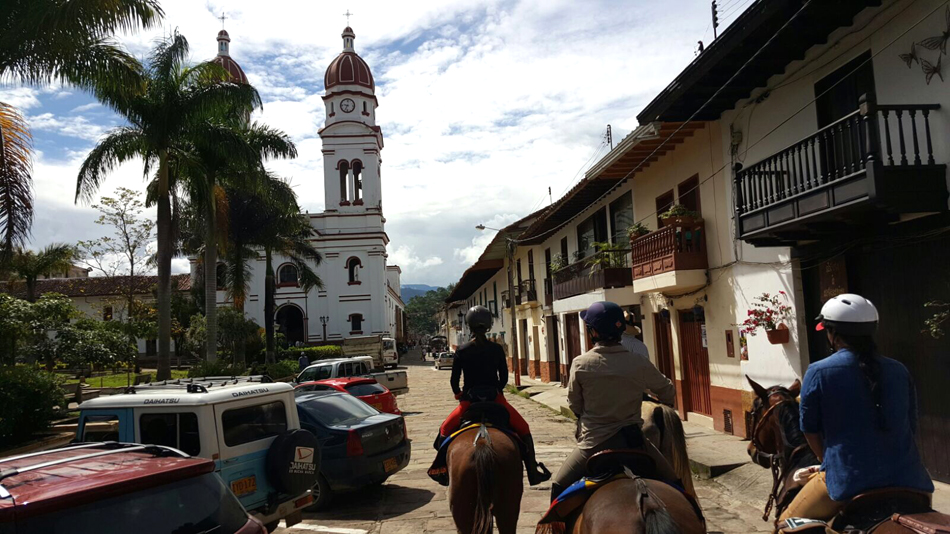
Views of riding through Colombia
I would recommend this tour for experienced trail riders who are adventurous and enjoy exploring up-and-coming countries in terms of tourism. We met friendly locals everywhere and enjoyed following the footsteps of Simon Bolivar who aided Colombia in its independence from Spain. I loved the Spanish influence of the area with the cobblestone streets in the towns and villages which date back to the 16th century. The food was fresh and nourishing and we all enjoyed the fresh juice options available daily and the home cooked meals. The accommodations were quaint and comfortable, ranging from village hotels to family owned haciendas in the area. Julio, his daughter and their support staff did a wonderful job of making sure everyone had a great time on the ride, the horses were fresh and ready to go, surefooted and fun to ride and gave us their all until the last day.


